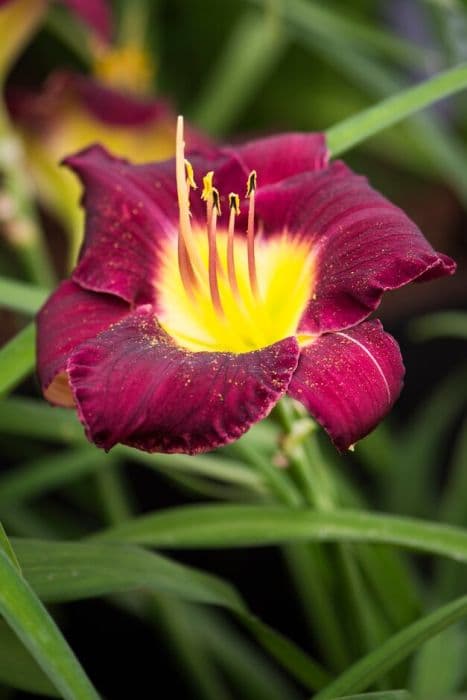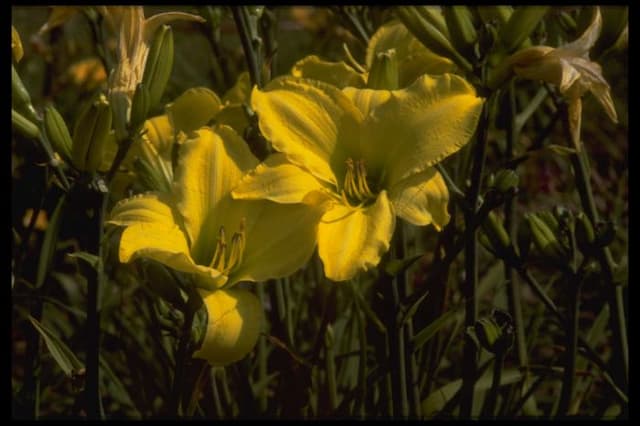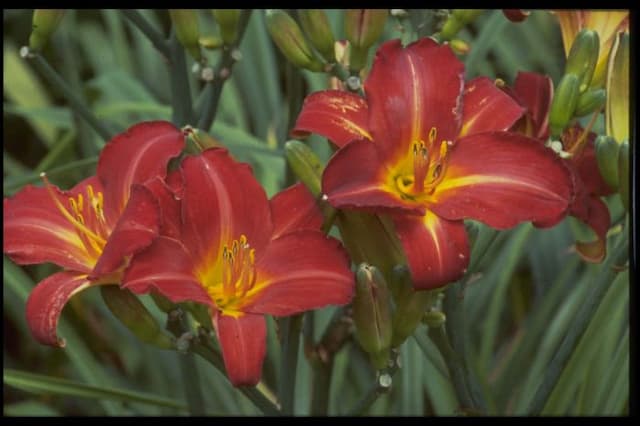Daylily Hemerocallis 'Dancing in the Rain'

ABOUT
The Daylily 'Dancing in the Rain' is a captivating perennial notable for its striking flowers. This variety boasts blooms that have a unique and elegant appearance, usually displaying a blend of soft, pastel to vibrant colors. The petals are often ruffled or wavy, adding to their graceful allure, and can sometimes have contrasting eye zones or edges that enhance their beauty. The throat of the flowers might exhibit a different shade, which creates a stunning visual effect. The foliage of 'Dancing in the Rain' is grass-like, forming a dense clump of long, narrow leaves that arch gracefully, providing a lush background for the standout blooms. The leaves are typically a rich, green color and have a slightly ribbed texture, which adds to the plant's overall visual interest. The plant's blooms are held aloft on sturdy scapes that rise above the foliage, and each bloom typically lasts just one day, though the plant produces many buds that open over a period of time, ensuring a long season of color. The flowers can attract butterflies and other pollinators to the garden, adding to the dynamic charm of this delightful daylily.
About this plant
 Names
NamesFamily
Asphodelaceae
Synonyms
Daylily
Common names
Hemerocallis 'Dancing in the Rain'
 Toxicity
ToxicityTo humans
The plant commonly known as daylily is not considered toxic to humans. In fact, some species of daylilies are even edible and have been used in culinary practices, particularly in Asian cuisines. However, it's important to note that not all plants that look like daylilies are safe to eat, as some may cause allergic reactions or have been treated with pesticides. If an unidentified plant has been ingested, it is recommended to seek medical advice. Always ensure correct identification and safety before consuming any plant materials.
To pets
The plant commonly known as daylily is potentially toxic to cats and may cause kidney failure if ingested. Symptoms of daylily poisoning in pets, particularly cats, may include vomiting, lethargy, kidney failure, and lack of appetite. Immediate veterinary attention is crucial if a pet has eaten any part of a daylily plant. The toxicity appears to be less severe in dogs, but to ensure the safety of all pets, it is recommended to prevent them from ingesting any part of the plant.
 Characteristics
CharacteristicsLife cycle
Perennials
Foliage type
Deciduous
Color of leaves
Green
Flower color
Mixed
Height
2 feet (60 cm)
Spread
2 feet (60 cm)
Plant type
Herb
Hardiness zones
3-9
Native area
Asia
Benefits
 General Benefits
General Benefits- Attracts Pollinators: Hemerocallis 'Dancing in the Rain’ provides nectar and pollen that attract bees, butterflies, and other beneficial insects.
- Low Maintenance: This daylily variety requires minimal care once established, making it ideal for gardeners seeking low-maintenance plants.
- Drought Tolerance: It has good drought resistance, requiring less watering in comparison to many other garden plants.
- Landscape Versatility: The plant can be used in a variety of landscape designs including borders, beds, and containers.
- Long Blooming: The daylily offers a long flowering period, often blooming for several weeks and providing lasting color in the garden.
- Tolerates Various Soil Types: It is adaptable to a range of soil conditions, though it prefers well-draining soil.
- Pest Resistance: Generally resistant to many pests, reducing the need for chemical treatments.
- Easy to Propagate: Daylilies can be easily propagated through division, allowing gardeners to expand their garden or share with others.
 Medical Properties
Medical PropertiesThis plant is not used for medical purposes.
 Air-purifying Qualities
Air-purifying QualitiesThis plant is not specifically known for air purifying qualities.
 Other Uses
Other Uses- Edible Flowers: The flowers of the daylily 'Dancing in the Rain' are edible and have a slightly sweet, vegetal flavor, commonly used in salads or as garnishes for a delicate touch to various dishes.
- Dye Production: The petals and other plant parts can be used to create natural dyes for textiles or crafting, producing soft colors that can vary depending on the mordant used.
- Water Filtration: The root system of daylilies can help in filtering and cleaning water bodies by absorbing nutrients and pollutants, playing a role in phytoremediation.
- Companion Planting: Daylilies can be planted amongst vegetables as companion plants to help deter certain pests or attract beneficial insects to the garden.
- Creative Crafts: The sturdy flower stalks of the daylily can be used in floral arrangements or for making unique, natural craft items like plant-based jewelry.
- Erosion Control: The daylily’s fibrous root system can help in stabilizing soil and preventing erosion on slopes and banks.
- Fish Ponds: Daylilies can be planted around fish ponds for aesthetic enhancement while their roots help stabilize the pond banks and provide hiding spots for small fish or amphibians.
- Living Mulch: Dense plantings of daylilies can act as a living mulch, helping to retain soil moisture and suppress weed growth due to their thick foliage.
- Bioindicator: Daylilies can serve as bioindicators, where changes in their growth or appearance might signal changes in environmental conditions, such as soil health or water quality.
- Permaculture Gardens: Incorporated into permaculture designs, daylilies can provide multiple functions such as food, aesthetics, and soil stabilization, embodying the principle of stacking functions in sustainable agriculture.
Interesting Facts
 Feng Shui
Feng ShuiThe Daylily is not used in Feng Shui practice.
 Zodiac Sign Compitability
Zodiac Sign CompitabilityThe Daylily is not used in astrology practice.
 Plant Symbolism
Plant Symbolism- Endurance: The common name "Daylily" suggests that each bloom lasts for only one day, symbolizing the transient nature of life and the ability to endure and persist through each day, moment by moment.
- Adaptability: Daylilies are known for their ability to thrive in a variety of conditions, symbolizing adaptability and the capacity to prosper in different environments and situations.
- Motherhood: In China, daylilies are associated with motherhood and fertility, making them a symbol of nurturing and the creation of new life.
- Embracing Challenges: The name 'Dancing in the Rain' suggests a positive attitude towards challenges, symbolizing the ability to find joy even during difficult times and to embrace life's adversities with a dance-like grace.
 Water
WaterDaylilies, including the 'Dancing in the Rain' variety, should be watered deeply about once a week, providing enough water to soak the root zone. During periods of high heat or drought, increase watering frequency to twice a week. Apply approximately 1 inch of water each time, which roughly translates to about 0.6 gallons per square foot. Avoid overhead watering to reduce the risk of leaf diseases and irrigate early in the day to allow foliage to dry. Always allow the soil to dry out slightly between waterings to prevent overwatering and root rot.
 Light
LightDaylilies like 'Dancing in the Rain' thrive in full sun conditions, which means they should receive at least six hours of direct sunlight each day. They can tolerate some light shade, especially in hot climates where afternoon shade can prevent scorching. Plant them in a spot where they will receive ample morning sun and some protection from the intense late afternoon sun if necessary.
 Temperature
TemperatureDaylilies, such as 'Dancing in the Rain,' are quite adaptable to temperature variations and can survive in minimum temperatures as low as -20 to -30 degrees Fahrenheit, although they grow best when the temperature remains above freezing. The ideal growing temperature for daylilies is between 50 and 90 degrees Fahrenheit. They're heat-tolerant and typically perform well in the summer garden with proper care.
 Pruning
PruningPruning 'Dancing in the Rain' daylilies involves removing spent flower stalks, which can promote a cleaner garden appearance and sometimes encourage reblooming. Prune back the foliage to the ground level at the end of the growing season in late fall. Daylilies should be divided and pruned every three to five years to maintain vigor and bloom quality, ideally in the spring or immediately after flowering.
 Cleaning
CleaningAs needed
 Soil
SoilThe Daylily 'Dancing in the Rain' thrives in well-draining soil with a mix of loamy soil, peat moss, and perlite or sand to enhance drainage. A slightly acidic to neutral soil pH of 6.0 to 7.0 is ideal for this plant. Ensure the soil is fertile and amend with compost annually for best growth.
 Repotting
RepottingDaylilies, including 'Dancing in the Rain', typically don't need frequent repotting as they are commonly grown outdoors. If grown in containers, consider repotting every 3-4 years to refresh the soil and expand the root space.
 Humidity & Misting
Humidity & MistingDaylilies such as 'Dancing in the Rain' are not very sensitive to humidity levels and can tolerate a range of conditions. They perform well in the average outdoor humidity and do not require special humidity adjustments.
 Suitable locations
Suitable locationsIndoor
Place the Daylily in a bright spot; water well.
Outdoor
Plant in full sun to partial shade; water deeply.
Hardiness zone
3-9 USDA
 Life cycle
Life cycleThe life of Daylily 'Dancing in the Rain' starts with seed germination, which occurs in moist soil with ample warmth. After germination, the seedling grows into a young plant with foliage and a developing root system. As the plant matures, it forms a clump with multiple shoots and extensive roots. Vegetative growth continues, with the plant producing strap-like leaves and increasing in size. The Daylily reaches reproductive maturity and begins to flower during the warmer months, displaying its distinctive blooms that last for just a day each. After flowering, the plant may produce seed pods if the flowers are pollinated, completing its life cycle, or it may continue to grow vegetatively, with clumps potentially being divided to propagate new plants.
 Propogation
PropogationPropogation time
Spring to early summer
The Hemerocallis 'Dancing in the Rain', commonly known as Daylily, is often propagated through division. The best time for this is either in the spring or the fall when the plant is not in active bloom. To propagate by division, carefully dig up the entire clump and gently separate the fans of leaves with their attached roots. Each division should have at least two or three fans to ensure a good chance of survival. Replant the divisions immediately, setting them at the same soil depth they were originally growing at and water them well. This straightforward method is widely used because it maintains the characteristics of the parent plant and allows the gardener to quickly increase their stock of the Daylily.









